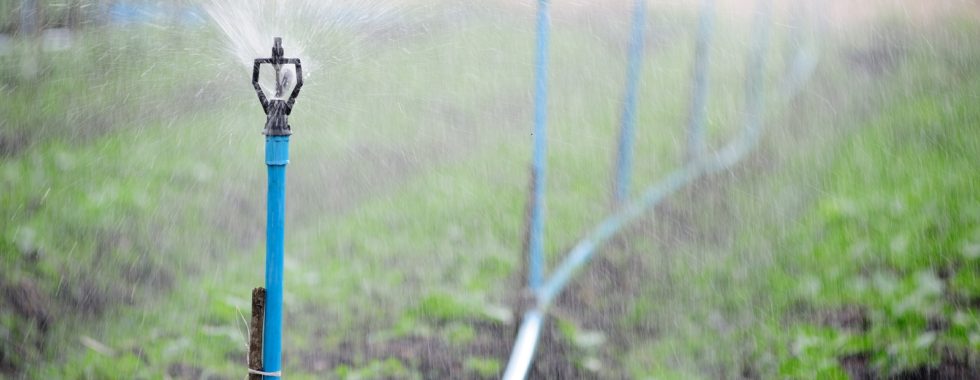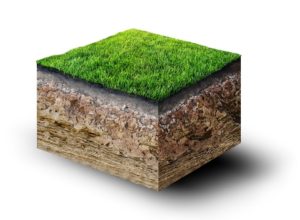Irrigation scheduling using evapotranspiration data
Irrigation scheduling refers to the timing, frequency and amount of water applied to the crop. In other words – when and how much to irrigate.
There are various methods and models to determine irrigation scheduling. Methods are usually based on soil moisture status, climatic parameters and plant development rate.
The following method involves doing the balance between the estimated soil moisture content and the amount of water lost from the soil by transpiration from plants’ leaves and by evaporation from the soil surface.
This method requires knowledge of the soil type, its water holding capacity and the actual evapotranspiration, taking into account the development stage of the crop.
SOIL MOISTURE
The soil provides the medium in which water is stored. Soil voids are filled either with air or water. Since each soil has a different distribution of particle sizes, the size of the pores, and as a result, the amount of water that they can hold varies. For example, sandy soils can hold less water than clay soils.
However, not all the water in the soil is available to plants. A certain amount of water is held strongly inside tiny pores and cannot be extracted by the plant. Therefore, the ‘available water’ has to be determined for each soil.
The available water is defined as the fraction of the soil volume between field capacity and permanent wilting point. For example, a value of 0.2, means that when the soil is saturated, the available water amount equals to 20% of the soil volume.
How can the Total Available Water be obtained? Simply by multiplying the available water fraction by the relevant soil volume.
Soil volume = plot area X active root system depth.
For example, if the active root system reaches 30 cm (12 inch), and available water fraction is 0.2, then:
Total Available Water = 0.2 X 10,000 m2/ha X 0.3 m = 600 m3
When the soil is sufficiently wet, the water supply to the crop is high enough meet its water demand, and water uptake rate equals to the actual evapotranspiration rate.
As the water content of the soil decreases, the soil water becomes more difficult to extract.
[visual-link-preview encoded=”eyJ0eXBlIjoiaW50ZXJuYWwiLCJwb3N0Ijo5MzY5LCJwb3N0X2xhYmVsIjoiUGFnZSA5MzY5IC0gU29pbCBtb2lzdHVyZSBtdWx0aSBzZW5zb3IiLCJ1cmwiOiIiLCJpbWFnZV9pZCI6OTI5MSwiaW1hZ2VfdXJsIjoiaHR0cHM6Ly9jcm9wYWlhLmNvbS93cC1jb250ZW50L3VwbG9hZHMvMjAxOC8wOS9Tb2lsLXNlbnNvci5qcGciLCJ0aXRsZSI6IlNvaWwgbW9pc3R1cmUgbXVsdGkgc2Vuc29yIiwic3VtbWFyeSI6IlRoZSBNdWx0aS1zZW5zb3IgZG9lcyBub3QgcmVhZCByZWFsLXRpbWUgc29pbCBtb2lzdHVyZSwgYnV0IGFsc28gZXZhcG90cmFuc3BpcmF0aW9uLCBhaXIgdGVtcGVyYXR1cmUsIHJlbGF0aXZlIGh1bWlkdHkgYW5kIHJhZGlhdGlvbi4iLCJ0ZW1wbGF0ZSI6ImRlZmF1bHQifQ==”]
Readily Available Water
When the soil water content falls below a certain threshold value, the soil water can no longer be transported quickly enough towards the roots to meet the evapotranspiration rate. Therefore, we also define the Readily Available Water.
The fraction of TAW that a crop can extract from the root zone without suffering water stress water is the Readily Available Water (RAW).
Although this fraction is crop specific and depends also on evapotranspiration of the crop (ETc), a value of 0.35 can be used as a rule of thumb.
Therefore, Readily Available Water (RAW) = 0.35 X TAW.
Since the RAW provides the water that is available to the crop, it also determines the frequency of the irrigation applications, or the gap between irrigations.
In order to know when to irrigate, we now need to understand how much water is being depleted, or what is the water depletion rate.
The depletion depends on the amount of water that is absorbed by the plant and the amount of water that is evaporated from soil which is not covered by plants.
The process in which water is transferred to the atmosphere from leaves and from soil surface is called Evapotranspiration (ET) – evaporation + transpiration.
Plants absorb water in the transpiration process. Water is transferred to the atmosphere, from the surface area of its leaves, where larger leaves surface results in higher rate of water absorbed and transferred to the atmosphere.
Weather conditions, which include temperature, relative humidity and radiation, provide the driving force for evapotranspiration.
REFERENCE EVAPOTRANSPIRATION (ET0)
Standard evapotranspiration is defined as the evapotranspiration from plain grass. It is measured using a standard pan, with specific dimensions. The rate of water evaporation from the pan is designated as ET0. It is measured in millimeters per day (mm/day).
One millimeter of evapotranspiration equals to 10 m3/ha. For example ET0 of 7mm means that the amount of water lost from soil by evapotranspiration is 70 m3/ha.
ACTUAL EVAPOTRANSPIRATION (ETc) AND CROP COEFFICIENT Kc
The actual evapotranspiration is, in most cases, lower that ET0 because the plant does not cover the entire soil surface. Therefore, the ETc for a specific crop usually increases as it grows.
ETc is calculated by multiplying ET0 by a specific crop coefficient that corresponds with the phenological stage or growth status of the crop, taking into account the area occupied by its leaves and its water requirements at the specific growth stage.
For example, the Kc for the crop at its initial growth stage is 0.3, ET0 on a specific date is 7mm. Therefore, the water requirement of the crop at the initial growth stage is 0.3×7=2.1mm = 21 m3/ha.
Table 1. Example crop coefficients (Kc), based on growth stage.
| CROP | INITIAL | DEVELOPMENT | MID-SEASON | LATE SEASON | HARVEST |
|---|---|---|---|---|---|
| Green beans | 0.3-0.4 | 0.65-0.75 | 0.95-1.05 | 0.9-0.95 | 0.85-0.9 |
| Corn (grain) | 0.3-0.5 | 0.7-0.85 | 1.05-1.2 | 0.8-0.95 | 0.55-0.6 |
| Pepper | 0.3-0.4 | 0.6-0.75 | 0.95-1.1 | 0.85-1.0 | 0.8-0.9 |
| Dry onion | 0.4-0.6 | 0.7-0.8 | 0.95-1.1 | 0.85-0.9 | 0.75-0.85 |
[visual-link-preview encoded=”eyJ0eXBlIjoiaW50ZXJuYWwiLCJwb3N0Ijo5MzY5LCJwb3N0X2xhYmVsIjoiUGFnZSA5MzY5IC0gU29pbCBtb2lzdHVyZSBtdWx0aSBzZW5zb3IiLCJ1cmwiOiJodHRwczovL2Nyb3BhaWEuY29tL3NvaWwtbW9pc3R1cmUtbXVsdGktc2Vuc29yIiwiaW1hZ2VfaWQiOjkyOTEsImltYWdlX3VybCI6Imh0dHBzOi8vY3JvcGFpYS5jb20vd3AtY29udGVudC91cGxvYWRzLzIwMTgvMDkvU29pbC1zZW5zb3IuanBnIiwidGl0bGUiOiJTb2lsIG1vaXN0dXJlIG11bHRpIHNlbnNvciIsInN1bW1hcnkiOiJBbGwtaW4tb25lIHNlbnNvci4gVGhlIGlkZWFsIGNvbWJpbmF0aW9uIGZvciBwcmVjaXNlIGlycmlnYXRpb24gbWFuYWdlbWVudC4gU29pbCBtb2lzdHVyZSwgRVQgYW5kIG1hbnkgb3RoZXIgaW1wb3J0YW50IHBhcmFtZXRlcnMuIExlYXJuIG1vcmUuIiwidGVtcGxhdGUiOiJkZWZhdWx0In0=”]
PUTTING IT ALL TOGETHER
Once we know the water holding capacity of the soil and the Readily Available Water )RAW), we can easily come up with an adequate irrigation regime.
Here are the steps:
- Record the daily ET0
- Multiply ET0 by the Kc that corresponds with the crop growth stage, to obtain ETc.
The daily water requirement in m3/ha equals 10 times the ETc. - The RAW (in m3) is the required water amount per irrigation. Divide RAW (in m3) by the daily water requirement, to obtain the irrigation interval.
- Add 15-20% to the required water amount, in order to account for the leaching requirement (“extra” water applied in order to leach excess of salts from the root zone).
NUMERICAL EXAMPLE
Assume the following:
0.4 ha (1 acre) plot.
Average weekly ET0 = 5 mm/day.
Kc of the crop = 0.4.
RAW = 60 m3/ha (6mm).
ETc = 0.4×5 = 2 mm/day = 20 m3/ha/day.
Irrigation interval = RAW/daily water requirement = 60/20
= 3 days.
Required water amount per irrigation = RAW + 0.15RAW = 60 + 9 = 69 m3/ha (6.9mm).
Therefore:
Apply 69 m3/ha (6.9mm) every 3 days.
Since the plot’s area is 0.4ha (1 acre), apply to that plot 27.6 m3 (0.26 acre-inch) every 3 days.
Note that by using this method, the water application amount does not change, only the water application interval.
This way, we always bring the soil to the same moisture status with each irrigation.
Another way to manage it, is by subtracting the daily water requirement from the RAW and irrigate when it becomes zero.
For example, if RAW is 200 m3 and we have the following readings of ET0:
Day 1 – 4mm, Day 2 – 5mm, Day 3 – 6mm, Day 4 – 4mm, Day 5 – 7mm, Day 6 – 4mm.
At day 1, the balance is: 200 – 40 = 160
At day 2: 160 – 50 = 110
At day 3: 110 – 60 = 50
Remaining available water At day 4: 50 – 40 = 10. This is the moment to irrigate.




